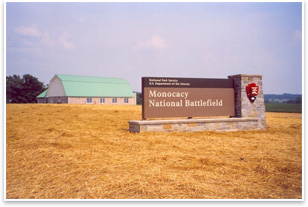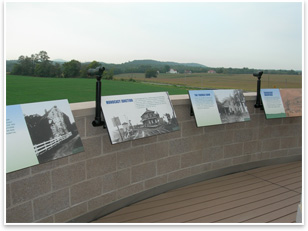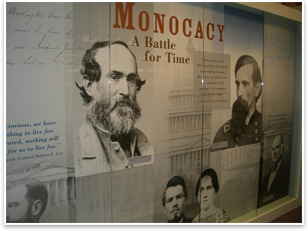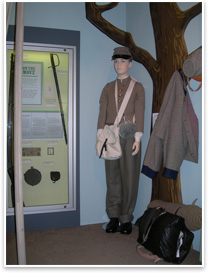Monocacy National Battlefield Visitor Center Provides a Museum Experience
New Civil War battlefield visitor center combines artifacts with modern design
by Russell Boniface
Associate Editor
 How do you . . . create a state-of-the-art visitor center with museum-style exhibits on a tight budget? How do you . . . create a state-of-the-art visitor center with museum-style exhibits on a tight budget?
Summary: The new $5 million Monocacy National Battlefield Visitor Center offers a museum experience for Civil War buffs and the general public alike. Opened this summer, the state-of-the-art Monocacy Visitor Center in Frederick, Md., sits on open farmland at the site of the Battle of Monocacy, an overlooked but pivotal historical Civil War battle fought on July 9, 1864. The simple cinderblock, green gambrel-roofed facility is a replica of the barn style of the surrounding farm landscape. Inside the 7,500-square-foot visitor center, modern technology combines with artifacts in 3,500 square feet of state-of-the-art exhibit space, giving it more of an intimate museum atmosphere. The building was designed by Baltimore-based GWWO, its interior design concept by New York-based contractors Exhibit A, and its exhibit displays by Manassas, Va.-based Capital Exhibits.
 The Battle of Monocacy, also called the “Battle that Saved Washington,” was fought on 1,650 acres of farms and cornfields 35 miles north of Washington, D.C. Confederate forces led by General Jubal Early attacked an outnumbered Union defense led by General Lew Wallace with the intent of proceeding to Washington. The battle resulted in 2,400 casualties. Although the Union army suffered more than half of those casualties, it delayed the Confederate march toward the Northern capital by one day, long enough for Union reinforcements to meet the Confederates on July 11 when they arrived at Fort Stevens, inside the city. The Union troops prevented the Confederates from taking the capital and forced General Early and his troops to retreat. The Battle of Monocacy, also called the “Battle that Saved Washington,” was fought on 1,650 acres of farms and cornfields 35 miles north of Washington, D.C. Confederate forces led by General Jubal Early attacked an outnumbered Union defense led by General Lew Wallace with the intent of proceeding to Washington. The battle resulted in 2,400 casualties. Although the Union army suffered more than half of those casualties, it delayed the Confederate march toward the Northern capital by one day, long enough for Union reinforcements to meet the Confederates on July 11 when they arrived at Fort Stevens, inside the city. The Union troops prevented the Confederates from taking the capital and forced General Early and his troops to retreat.
More than glass cases
The new two-story, federally funded Monocacy National Battlefield Visitor Center captures the events before, during, and after the Battle of Monocacy. The new center has more exhibit space than its predecessor and is designed to accommodate more people. The center sits on the Best Farm, the starting point of the battle. Inside, the second floor showcases crisp and colorful design exhibits and lighted glass wall displays detailing the battle’s history, all underneath a raised, wood ceiling that evokes a barn environment. Wall displays feature pictures and stories of the battle, Generals Early and Wallace, maps and strategies, and details about pre-Civil War events and figures, such as abolitionist John Brown and the election of 1860 that led to secession. An overhead wall timeline details specific national events that preceded the Monocacy battle, the battle itself, and its impact afterwards.
 Theatrical exhibit vignettes tell the Monocacy story from the perspectives of Confederate and Union soldiers and civilians, employing handheld audio devices to allow visitors to hear insightful accounts of the battle from both sides. Another design display recreates the Best Farm and recounts experiences of its residents as it was taken over by soldiers. A large fiber-optic display map that shows the sequence of the battle and interactive question boards allow visitors to test their battle knowledge. Visitors can try out technology of the 19th century, including a telegraph using Morse code. Authentic relics—guns, swords, artillery, backpacks, newspaper articles, a 17th Virginia Calvary flag, and clothing—abound. Visitors can even try on a Confederate uniform. Outside, a second-story balcony has mounted telescopes overlooking farms and farm houses where Monocacy’s battles took place. Theatrical exhibit vignettes tell the Monocacy story from the perspectives of Confederate and Union soldiers and civilians, employing handheld audio devices to allow visitors to hear insightful accounts of the battle from both sides. Another design display recreates the Best Farm and recounts experiences of its residents as it was taken over by soldiers. A large fiber-optic display map that shows the sequence of the battle and interactive question boards allow visitors to test their battle knowledge. Visitors can try out technology of the 19th century, including a telegraph using Morse code. Authentic relics—guns, swords, artillery, backpacks, newspaper articles, a 17th Virginia Calvary flag, and clothing—abound. Visitors can even try on a Confederate uniform. Outside, a second-story balcony has mounted telescopes overlooking farms and farm houses where Monocacy’s battles took place.
 Team effort; choosing a site Team effort; choosing a site
Monocacy National Battlefield curator and park ranger Tracy Shives explains that teamwork was the key to the success of the visitor center project. “We did all the writing for the exhibits and provided the text to contractors Exhibit A, which created the visitor center design concept,” explains Shives. “We gave them a lot of information on the history and story of the battle; they poured over it, then came up with the concepts on how it could be presented. GWWO did the architectural drawings for the building, while Capital Exhibits provided the fabrication for the exhibit displays. It was a combination of all of us working together.”
Shives explains that determining the architecture and site of the new building was a process involving some interesting issues. “Originally, GWWO was going to put the visitors center in an existing 1950s cinderblock dairy barn across the road on that side of the Best Farm. We had the architectural drawings done, but what happened was they decided the building was not structurally sound anymore. It also would have involved so much money to redo the barn to make it into a visitors center. Then, there was an issue with the water and sewer lines, because they actually run on this side of the road, not across the road.”
 Gathering artifacts Gathering artifacts
The artifacts for the center came from several sources. “Probably about 85 percent of our collection was in storage at the old visitor center, so we worked them into the exhibits, and now everything is pretty much on display,” Shives says. “We also have what our archeologist found on the field. But the majority of artifacts were donated to the park. For example, we have a long-term loan with the Ben Hur Museum in Crawfordsville, Ind., because Union General Lew Wallace wrote Ben Hur. We have from them his military trunk, his tunic with the epaulets, and the 17th Virginia Calvary flag, and in return we agreed to do the restoration work on them. When we had our groundbreaking, someone who does a lot of donating to the park noticed we had a lot more items for the Union troops than the Confederates, so he donated a lot of Confederate items to help balance out our collection.”
The Monocacy National Battlefield Visitors Center is rounded out with an information center and bookstore on the ground level. Last year, 17,000 people visited the original, smaller visitor center, which was about one mile down the road from the new visitor center. |






